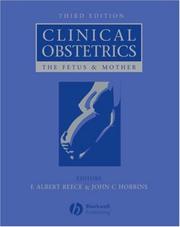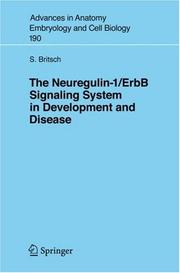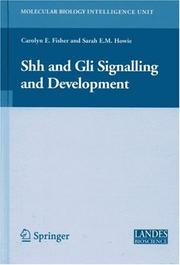| Listing 1 - 7 of 7 |
Sort by
|
Book
Year: 2007 Publisher: Bruxelles: UCL,
Abstract | Keywords | Export | Availability | Bookmark
 Loading...
Loading...Choose an application
- Reference Manager
- EndNote
- RefWorks (Direct export to RefWorks)
Onecut (OC) transcription factors are proteins conserved among species, which have important functions in the embryonic development. The human genome contains three Onecut members, known as HNF-6 (OC-1), OC-2 and OC-3. The OC-2 transcription factor that is of specific interest in this work is expressed in the developing liver and pancreas, among others. It has previously been discovered in the host laboratory that the Oc2 gene possesses several sites within its 3'untranslated region (3'UTR), that are targets for the microRNA 218 (miR-218). The objective of this work is to study a potential regulatory action of miR-218 on the expression of the OC-2 transcription factor. To this end, we constructed plasmids containing the 3'UTR region of Oc2, cloned from a reporter luciferase gene. The different plasmids contain 3'UTR regions of variable length and various numbers of target-regions for miR-218. These plasmids have been transfected into cultured cells in either presence or absence of miR-218. The results show that the presence of miR-218 is able to lower the level of expression of a reporter gene regulated by the 3'UTR region of the Oc2 gene, and that two different effects exist: a non-specific effect and the specific regulation of miR-218. The number of potential targets for miR-218 also seems to have an effect on the level of expression of the gene. Indeed, the construction with a 3'UTR region containing only one target site for miR-218, exhibited a slightly higher level of expression then the other constructions with two or three target sites. As a conclusion, our results suggest that miR-218 regulates the expression of the reporter gene and is therefore a potential regulator for the Oc2 gene. Les facteurs de transcription Onecut (OC) sont des protéines conservées entre les espèces qui ont d'importantes fonctions dans le développement embryonnaire. Le génome humain contient trois membres de la famille Onecut, à savoir HNF-6 (OC-1), OC-2 et OC-3. Le facteur de transcription OC-2 qui nous intéresse pour ce travail est notamment exprimé dans le foie et le pancréas en développement. Il a été découvert précédemment au laboratoire d'accueil que le gène Oc2 possède au sein de sa région 3' non traduite (3'UTR) plusieurs sites qui sont des cibles du microRNA 218 (miR-218). L'objectif de ce mémoire est d'étudier une action régulatrice potentielle de miR-218 sur l'expression du facteur de transcription OC-2. A cette fin, nous avons construit des plasmides contenant la région 3'UTR de Oc2 clonée en aval d'un gène rapporteur luciférase. Les différents plasmides comportent des 3'UTR de longueur variable et contiennent des nombres différents de régions-cibles de miR-218. Ces plasmides ont été transfectés dans des cellules en culture en présence ou en absence de miR-218. Les résultats de ce travail montrent que la présence de miR-218 est capable de diminuer le niveau d'expression d'un gène rapporteur régulé par la région 3'UTR du gène Oc2 et qu'il existe deux effets différents, à savoir un effet non spécifique et une régulation spécifique de miR-218. Le nombre de cibles potentielles de miR-218 semble également avoir un effet sur le niveau de l'expression du gène. En effet, la construction possédant une région 3'UTR ne contenant qu'un seul site cible de miR-218 présentait un niveau d'expression légèrement plus élevé que pour les autres constructions pourvues de deux ou trois sites cibles de miR-218. En conclusion, nos résultats suggèrent que miR-218 régule l'expression du gène rapporteur et qu'il est donc un régulateur potentiel du gène Oc2.
Onecut Transcription Factors --- MicroRNAs --- Embryonic Development
Dissertation
Year: 2007 Publisher: [S.l.]: [chez l'auteur],
Abstract | Keywords | Export | Availability | Bookmark
 Loading...
Loading...Choose an application
- Reference Manager
- EndNote
- RefWorks (Direct export to RefWorks)
Phaseolus coccineus --- Phaseolus coccineus --- Phaseolus vulgaris --- Phaseolus vulgaris --- Interspecific hybridization --- Interspecific hybridization --- Embryonic development --- Embryonic development

ISBN: 9780415399739 0415399734 Year: 2007 Publisher: London : Informa Healthcare,
Abstract | Keywords | Export | Availability | Bookmark
 Loading...
Loading...Choose an application
- Reference Manager
- EndNote
- RefWorks (Direct export to RefWorks)
Embryo Transfer. --- Preimplantation Diagnosis. --- Blastocyst --- Embryo Implantation. --- Embryonic Development. --- Human embryo --- Preimplantation genetic diagnosis --- Embryon humain --- Diagnostics préimplantatoires --- metabolism. --- Transplantation --- Transplantation

ISBN: 1405132167 9781405132169 0470753293 9786610748471 0470762837 1280748478 1405171839 Year: 2007 Publisher: Malden Blackwell Publishing
Abstract | Keywords | Export | Availability | Bookmark
 Loading...
Loading...Choose an application
- Reference Manager
- EndNote
- RefWorks (Direct export to RefWorks)
Embryonic Development. --- Fetal Development. --- Fetal Diseases. --- Maternal-Fetal Exchange. --- Maternal-fetal exchange. --- Obstetrics. --- Pregnancy Complications. --- Pregnancy --- Pregnancy. --- Prenatal Diagnosis. --- Prenatal diagnosis. --- Complications. --- Physiology. --- Embryonic Development --- Maternal-Fetal Exchange --- Prenatal diagnosis --- Maternal-fetal exchange --- Fetal Diseases --- Fetal Development --- Pregnancy Complications --- Prenatal Diagnosis --- Obstetrics --- physiology --- Complications --- Foetale ontwikkeling --- Verloskunde --- Zwangerschap --- Complications of pregnancy --- High-risk pregnancy --- Pregnancy, Complications of --- Pregnant women --- Obstetrical emergencies --- Antenatal diagnosis --- Intrauterine diagnosis --- Prenatal testing --- Diagnosis --- Gestation --- Conception --- Physiology --- Reproduction --- Maternal-fetal medicine --- Medicine --- Fetus --- Placenta --- Diseases --- Pregnancy - physiology --- Pregnancy - Complications
Periodical
ISSN: 22880178 Year: 2007 Publisher: Wonju, Republic of Korea : Korean Society of Animal Reproduction and Biotechnology,
Abstract | Keywords | Export | Availability | Bookmark
 Loading...
Loading...Choose an application
- Reference Manager
- EndNote
- RefWorks (Direct export to RefWorks)
Embryo transplantation --- Embryology --- Embryo transplantation. --- Embryology. --- Animal embryology --- Animals --- Development, Embryological --- Development, Embryonic --- Development, Zygotic --- Embryogenesis --- Embryogeny --- Embryological development --- Embryonic development --- Zoology --- Zygote development --- Zygotes --- Zygotic development --- Zygotic embryogenesis --- Developmental biology --- Morphology (Animals) --- Embryos --- Reproduction --- Embryo transfer --- Transfer of embryo --- Reproductive technology --- Transplantation of organs, tissues, etc. --- Development

ISBN: 1280853654 9786610853656 3540371079 3540371052 Year: 2007 Publisher: Berlin ; New York : Springer,
Abstract | Keywords | Export | Availability | Bookmark
 Loading...
Loading...Choose an application
- Reference Manager
- EndNote
- RefWorks (Direct export to RefWorks)
Neuregulins are EGF-like growth and differentiation factors that interact with tyrosine kinase receptors of the ErbB family. this signailing system has a wide range of functions during development of the nervous system, the heart, and the mammary gland. Furthermore, Neuregulin signals are also involved in the development of human diseases including breast cancer, heart disease and the pathogenesis of schizophrenia. This monograph reviews the biology of Neuregulins and their receptors and summarizes recent research, which has established crucial functions of this signaling system during development and disease. .
Embryology. --- Cell interaction. --- Receptor-ligand complexes. --- Growth factors. --- Ligand-receptor complexes --- Receptor complexes (Biochemistry) --- Cell receptors --- Ligand binding (Biochemistry) --- Cell-cell interaction --- Cell communication --- Cellular communication (Biology) --- Cellular interaction --- Intercellular communication --- Cellular control mechanisms --- Animal embryology --- Animals --- Development, Embryological --- Development, Embryonic --- Development, Zygotic --- Embryogenesis --- Embryogeny --- Embryological development --- Embryonic development --- Zoology --- Zygote development --- Zygotes --- Zygotic development --- Zygotic embryogenesis --- Developmental biology --- Morphology (Animals) --- Embryos --- Reproduction --- Cell growth factors --- Cellular growth factors --- Growth peptides --- Growth promoting substances --- Growth substances --- Peptide growth factors --- Peptide regulatory factors --- Polypeptide growth factors --- Cytokines --- Peptides --- Embryology --- Development --- Medicine. --- Molecular Medicine. --- Clinical sciences --- Medical profession --- Human biology --- Life sciences --- Medical sciences --- Pathology --- Physicians --- Health Workforce --- Molecular biology. --- Molecular biochemistry --- Molecular biophysics --- Biochemistry --- Biophysics --- Biomolecules --- Systems biology --- Medicine --- Biology --- Biomedical Research. --- Research. --- Biological research --- Biomedical research

ISBN: 0387399569 9786611378035 1281378038 0387399577 Year: 2007 Publisher: New York, NY : Springer New York : Imprint: Springer,
Abstract | Keywords | Export | Availability | Bookmark
 Loading...
Loading...Choose an application
- Reference Manager
- EndNote
- RefWorks (Direct export to RefWorks)
he hedgehog signalling pathway is highly conserved and seen in organisms ranging from Drosophila to humans. This pathway is Tcritical in determining cell fate decisions in a variety of different cell types. There are several vertebrate analogues of the Drosophila hedgehog protein of which the most widely studied is Sonic hedgehog (Shh). Shh signalling classically involves the Gli family of zinc-fmger transcription factors. The Shh signalling pathway is well characterised in the develop ment of a number of vertebrate organ systems. It could indeed be argued that the Shh and Gli signalling may well be involved at some stage in the development of all the major organ systems in vertebrates. This volume rep resents a concerted drive to bring together *state of the art' reviews by lead ing experts in the field of Shh and Gli signalling in development from all over the world. The chapters span vertebrate organisms from zebrafish to humans and cover development of the multiple organ systems in which the Shh signalling pathway is crucial for normal development. There are chap ters on the development of the central nervous system, skeletal struc tures, visceral organs, prostate, lung, immune system and the structures of the human face. The authors themselves span three major continents and multiple nationalities which admirably illustrates the worldwide nature of the science.
Cellular signal transduction. --- Developmental genetics. --- Embryonic Induction. --- Embryonic Induction - physiology. --- Morphogenesis - Molecular aspects. --- Morphogenesis. --- Organogenesis. --- Organogenesis - physiology. --- Signal Transduction. --- Signal Transduction - physiology. --- Transcription factors. --- Transcription Factors - genetics. --- Morphogenesis --- Transcription factors --- Cellular signal transduction --- Developmental genetics --- Biochemical Processes --- Embryonic and Fetal Development --- Biology --- Cell Communication --- Proteins --- Embryonic Development --- Body Patterning --- Cell Differentiation --- Cell Physiological Processes --- Biological Science Disciplines --- Amino Acids, Peptides, and Proteins --- Chemical Processes --- Reproduction --- Cell Physiological Phenomena --- Natural Science Disciplines --- Biochemical Phenomena --- Growth and Development --- Disciplines and Occupations --- Chemicals and Drugs --- Phenomena and Processes --- Chemical Phenomena --- Reproductive Physiological Processes --- Physiological Processes --- Reproductive Physiological Phenomena --- Reproductive and Urinary Physiological Phenomena --- Physiological Phenomena --- Signal Transduction --- Embryonic Induction --- Organogenesis --- Genetics --- Physiology --- Transcription Factors --- Health & Biological Sciences --- Biophysics --- Molecular aspects --- Cellular information transduction --- Information transduction, Cellular --- Signal transduction, Cellular --- Genetic transcription factors --- Molecular aspects. --- Life sciences. --- Human physiology. --- Cell biology. --- Developmental biology. --- Life Sciences. --- Developmental Biology. --- Cell Biology. --- Human Physiology. --- Development (Biology) --- Growth --- Ontogeny --- Cell biology --- Cellular biology --- Cells --- Cytologists --- Human biology --- Medical sciences --- Human body --- Biosciences --- Sciences, Life --- Science --- Developmental biology --- Embryology --- Bioenergetics --- Cellular control mechanisms --- Information theory in biology --- Molecular biology --- Cytology.
| Listing 1 - 7 of 7 |
Sort by
|

 Search
Search Feedback
Feedback About UniCat
About UniCat  Help
Help News
News